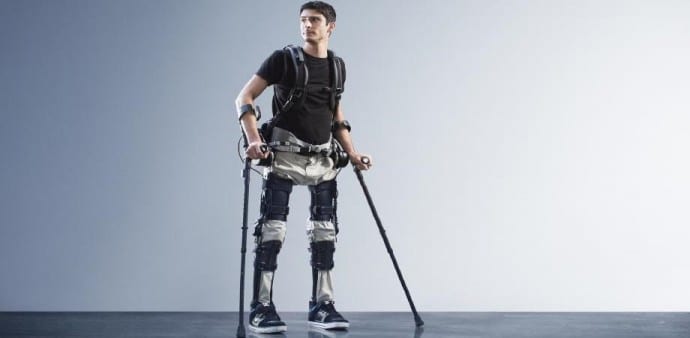This $40,000 Robotic Exoskeleton Helps Paralysis Patients Walk
Researchers in the U.S. are now displaying an exoskeleton device that’s almost ready to hit the market to help people who have been permanently paralysed walk again.
Created by the Berkeley-based company SuitX, the Phoenix is a 27-pound, $40,000 robot frame that can allow paraplegic people to walk. The Phoenix is among the lightest and cheapest medical exoskeletons. It also has unique abilities; the suit is modular and adjustable so it can adapt to, say, a relatively tall person who just needs mobility assistance for one knee. Phoenix could act as a replacement for a wheelchair, allowing them to take small but stable steps or even join in a game of soccer.
The suit returns movement to wearers’ hips and knees with small motors attached to standard orthotics. Wearers can control the movement of each leg and walk at up to 1.1 miles per hour by pushing buttons integrated into a pair of crutches.
“This machine helps with a couple of different things: rehab, exercise and involvement in everyday lives,” paraplegic Steve Sanchez told Fast Company. “I’m not the robot, I wear the robot. Of course, there’s other exoskeletons out there, but the big problem with those is their price points.”
The battery pack, worn on the user’s back, lasts up to 8 hours, depending on usage. Unlike single-piece exoskeletons, the Phoenix is able to be put on and taken off piece by piece, allowing the user to put it on unassisted. This also allows the suit to be customized for different body types. An app can be used to track the patient’s walking data. SuitX has mainly worked with patients with spinal cord injuries, who can use the Phoenix to walk again.
“We can’t really fix their disease. We can’t fix their injury. But what it would do is postpone the secondary injuries due to sitting,” says SuitX founder and CEO Homayoon Kazerooni. “It gives a better quality of life.”
Meanwhile, depending on the needs of the wearer, the modular nature of the suit means different parts can be added or removed: the Phoenix takes its cues from the design of the human body rather than the principles of industrial robotics.
Michael McKinley, one of the robotics engineers working on the project, says the efforts of volunteers Steve Sanchez and Daniel Fukuchi have been invaluable in developing the final design of the suit: “We’ve worked together, almost as a two-part team. We’re bringing the science and they’re bringing the insight from their reality.”
The technology behind SuitX’s industrial and medical exoskeleton originated at the Robotics and Human Engineering Laboratory at the University of California, Berkeley, which Kazerooni leads. Currently, the exoskeleton is only available for adults, but SuitX is continuing to develop the Phoenix and hopes to offer a model for children in the future. Children with neurological disorders sometimes need intensive walking training or can risk losing their mobility.
The device could also have therapeutic benefits for people who have experienced a stroke or other motor injury, but more research needs to be conducted.
Currently, the Phoenix is priced at $40,000. SuitX is hoping to boost interest in exoskeleton research with competitors like the ReWalk priced at $70,000; their device is a bit more manageable for the average person to afford.

